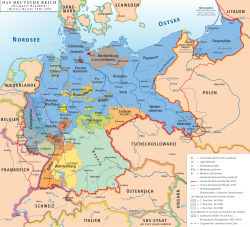Government
The state parliament consisted of a landtag of a varying number of members but not fewer than 50, elected for a term of three years by universal suffrage. The state administration, headed by a Minister-President was responsible to the landtag and could be removed by a vote of no confidence. [1] For most of the Weimar period, the state governments were headed by either a Social Democrat or a Nationalist. [2] However, in the June 1932 landtag election, the Nazi Party became the largest party with 49% of the vote and a Nazi, Walter Granzow, became Minister-President on 13 July. Thus, Mecklenburg-Schwerin was one of only five states to have installed a Nazi-led government before the Nazis came to power nationally. [3]
Following their seizure of power at the national level, the Nazi government enacted the "Second Law on the Coordination of the States with the Reich" that established more direct control over the states by means of the new powerful position of Reichsstatthalter (Reich Governor). Friedrich Hildebrandt was installed in this post on 26 May 1933. [4] By the end of the year, Hildebrandt, who was also Reichsstatthalter of the neighboring Free State of Mecklenburg-Strelitz, moved to consolidate his domains and merged the two states into a new united state of Mecklenburg, effective 1 January 1934. [4]
This page is based on this
Wikipedia article Text is available under the
CC BY-SA 4.0 license; additional terms may apply.
Images, videos and audio are available under their respective licenses.



